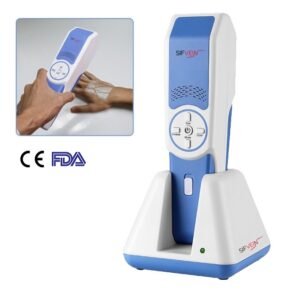Dialysis
Dialysis replaces the function of the kidneys in case of renal failure. Dialysis filters the patient’s blood by removing waste and excess fluid from his/her body. This waste is sent to the bladder to be eliminated when they urinate.
Hemodialysis
Hemodialysis is the most common type of dialysis. It’s a procedure done through a hemodialyzer, which is an artificial kidney. The blood leaves the body through tubes and circulates in the dialyzer machine in order to be filtered and cleaned before returning to the body.
The hemodialyzer is connected to the patient’s body through blood vessels. The most common ways of hemodialyzer-body connection are:
1- Arteriovenous Fistula (AVF): This technique connects an artery and a vein in any accessible part of the body (usually the arms or legs)
2- Vascular access catheter: This is inserted into the large vein in the patient’s neck.
The importance of vein finders in hemodialysis procedure
Hemodialysis is of vital importance to renal failure patients and it should be performed as carefully and safely as possible, especially that it occurs at least 3 times a weeks.
Difficulty finding the needed veins or arteries can make the whole process very painful. In addition, it can easily damage the vein in question through repetitive needle insertion into the body.
The invisibility of the patient’s vein can be cause by her/his age (elderly people), obesity, skin color, a long time of dialysis or simply any skin condition that affects the visibility of their veins.
In these cases, vein finders are essential to make the whole process easier and safer.
SIFVEIN vein detectors use a near-infrared technology that interacts with the blood color and illuminates the veins beneath the skin surface, making a visible vein map on the patient’s hand, arm, neck, etc.
Vein finders by SIFSOF provide a wide range of products (portable, desk type, head-mounted 3D, etc.) with different accessories, adaptable to the needs of both the doctor and the patient.
Dialysis patients need a scanning depth that equals or exceeds 10 mm, particularly in the arm and forearm in order to insert the fistula or the catheter.
SIFVEIN-4.2 has a scan depth of maximum 12 mm, perfect for mapping out veins in the arm and the forearm.
Reference : National Kidney Foundation
[launchpad_feedback]
Disclaimer: Although the information we provide is used by different doctors and medical staff to perform their procedures and clinical applications, the information contained in this article is for consideration only. SIFSOF is not responsible neither for the misuse of the device nor for the wrong or random generalization of the device in all clinical applications or procedures mentioned in our articles. Users must have the proper training and skills to perform the procedure with each vein finder device.
The products mentioned in this article are only for sale to medical staff (doctors, nurses, certified practitioners, etc.) or to private users assisted by or under the supervision of a medical professional.



